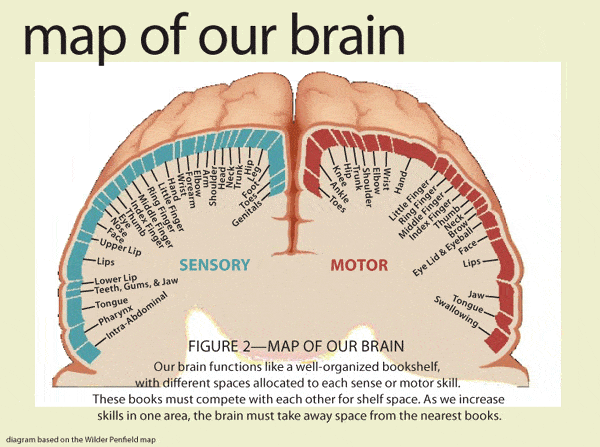Unsupervised learning plays a huge role in how we think and we make decisions. The basics of how we value situations and actions arise from unsupervised learning. The image below, originally by Wilder Penfield in the 1950s, illustrates that specific cortical areas are devoted to specific external body areas. This mapping is the result of unsupervised learning. It is not built-in at birth, nor is it the result of instruction.

Unsupervised learning, although it sounds like learning when the teacher is not around, actually entails learning by detecting patterns in data without using preexisting categories. That is, instead of a teacher pointing at a letter “A” and saying “A” again and again, you notice the shape of “A” from looking at signs. Of course, you don’t name it “A” and don’t know the sound it represents.
In the case of cut-and-dried facts, teacher led instruction is fastest, allowing wide schemes of organized information. However, what did we learn before we learned language? How do we handle situations that are so complex we cannot capture them in words? More
The answer, of course, is unsupervised learning. Consider creative writing, painting, song, dance, and the like, to learn one is exposed to master works—although teachers and texts may try to name what makes the work great—the student is expected to pull from the examples the essence of what makes the work great in its field. They are to detect the pattern that connects across the great examples and be able to see it in other great works and perhaps to create their own great work by following this pattern they learned.
Categorizing and Making-Decisions
From a more ordinary stance, your idiosyncratic needs, desires, and fears arise before they have labels, with defined meanings that constrain what they mean. Before you learn how others see you, you learn yourself. You have no words to define the feelings that accompany the satisfaction and frustration of your 3S Imperatives—Satiety, Sex, and Safety.
Unsupervised learning occurs when you integrate your own personal needs, desires, and fears into the bare natural reality you observe, live in, and act in. When connections between several components reoccur often, the pattern becomes a recognized relationship, which you use to guide subsequent actions. This follows from Hebb’s Law.
When neurons are repeatedly triggered, the connections between the firing neurons are strengthened. Thus repeated experience results in patterns of inputs yielding regular patterns of firing.
Even once you learn language and words describing internal feelings, we continue to struggle to relate how we feel, because the words aren’t an exact match.
Language
Language, as useful as it is, only provides a crude picture of one’s internal state. Although I may try to communicate my interior state to you, the disparate range of personal experiences means that only a part of my meaning will convey.
For instance, if I say, “Language opens a door to the mind,” door to me means a simple functional entry, while to you, it may also have overtones of a luxurious carved portal to a place of contentment or perhaps an entry that is always shut to you. Connotations like these are only the first layer of alteration of knowledge shared by language.
Nonetheless, once we learn language, the verbal hemisphere will use defined words to describe the world, removing any complexity our linguistic ability can’t encode.
Experience
Learning by experience is, at the base, unsupervised. We see patterns (or not) according to our personal perspective. When a parent or teacher does not tell us what an event is, we experience freely according to our own metrics. Our satisfaction or dissatisfaction determines our knowledge and memory. The experience is not determined by culture or academic beliefs, although once they are learned by supervision they are considered.
In gross terms, one hemisphere specializes in language and supervised learning. The other specializes in patterns and unsupervised learning. However, they are intimately interconnected across the corpus callosum, exchanging their different models of reality about 60 times from sensory receipt to executive decision-making, providing the opportunity to continue with the most fruitful description, be it word or pattern.
What is the difference between a word and a pattern? A word has a defined, shared meaning. A pattern has an approximate, personal meaning.
Concept Elevator
Sense information gets combined with memories of past situations, our needs, desires, and fears as they move towards our decision-making lobes. At each stop, we may detect patterns, relationships between situations, reactions, and results that can be used in handling the current situation. This is primarily by unsupervised learning. When we can apply supervised learned (preexisting, non-individual verbal descriptions), they are after-the-fact. We attempt to describe the ineffable with linguistic elements from cultural and social norms.
Summary
What if we only had supervised learning? If all learning were supervised—the categories, facts and relationships predefined—there would be no misunderstanding, but there would also be no progress, since all possibilities would already be defined. Nothing would be recognized beyond the preexisting categories.
Unsupervised learning is the way we develop our morals, realize our place in society, and form the groundwork that our decisions are based on.
3S Imperatives drive one’s assessment of a situation’s worth.
a piori operations a very limited set of neural operations that are not learned, but inborn.
Neural connections supporting unsupervised learning.
Corpus Callosum connect word and pattern views of the world.
Concept Elevator describes the progress of raw sensory information to conscious consideration in the frontal lobe.
Decision-Making, even when we are adults, the vestiges of our march through developmental steps form the basis of each succeeding step in the decision process.
Intuition’s Source, a consequence of Hebb’s Law.
Mental Construction Model develops a theory of cognition from basic survival, through emotional, and into a dual purpose rational thought—immediate response or delayed gratification.
